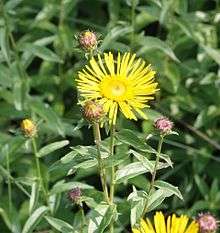Inula salicina
| Inula salicina | |
|---|---|
 | |
| Scientific classification | |
| Kingdom: | Plantae |
| (unranked): | Angiosperms |
| (unranked): | Eudicots |
| (unranked): | Asterids |
| Order: | Asterales |
| Family: | Asteraceae |
| Genus: | Inula |
| Species: | I. salicina |
| Binomial name | |
| Inula salicina L. 1753 not Bunge 1833 nor C.B.Clarke 1876 nor Pall. 1820 | |
| Synonyms | |
| |
Inula salicina (common name Irish fleabane (UK)[1] or willowleaf yellowhead) is a plant species in the genus Inula in the family Asteraceae.[2] It is found across Europe and Asia from Portugal to Japan. It has been reported growing in the wild in a few scattered locations in North America but it has not become widely established there.[3][4][5][6]
Discovery and taxonomy

Inula salicina was first described by Carl Linnaeus in 1753. It is one of about 90 species in the genus Inula.
Synonyms and common names
Inula salicina is known from a variety of common names including willowleaf yellowhead, Irish fleabane and willow-leaved Inula. Since its initial description it has also been ascribed a variety of Latin names, including Inula glabra, Conyza salicin, Aster spathularis, Aster rigidus, Jacobaea salicina and Aster salicinus all of which are now regarded as synonyms and probably reflecting the still uncertain taxonomy of the genus, it being regarded as possibly paraphyletic.
Distribution
Inula salicina is to be found extensively across mainland western Europe, from Spain through France, Benelux, Germany, Poland, Denmark and southern Scandinavia. It only has a very restricted distribution is the British Isles, being confined to a small area of south central Ireland, around Lough Derg in north Tipperary and south-east Galway. Indeed it is now reported[7] that it can only be found at a single locality, having been eliminated from former sites through human activity. The species has been become a flagship species and a focus for conservation efforts, with a co-ordinated program to reintroduce the plant already well underway. The plant is regarded a member of the Lusitanian flora[8] in that it is a member of a group of plants that are specific to south west Ireland, are not found in the rest of the British Isles and are plants that are more normally seen in the Mediterranean. It is not known how this group of plants became established in Ireland, but it is likely to have been in the last 10000 years since the end of the last ice age.
Description
Inula salicina is an upright herb, 20–80 centimetres (7.9–31.5 in) in height, with a thin stem, narrow, elongate, alternate, stemless leaves, which with the stem are roughly haired. The flower heads are carried singly at the top of the stem, are 2.5–4 centimetres (0.98–1.57 in) in diameter. Each head contains 35-70 yellow ray flowers containing 100-250 yellow disc flowers.[6]
References
- ↑ "BSBI List 2007". Botanical Society of Britain and Ireland. Archived from the original (xls) on 2015-01-25. Retrieved 2014-10-17.
- ↑ "Inula salicina". Integrated Taxonomic Information System. Retrieved March 10, 2012.
- ↑ "Encyclopedia of Life, Inula salicina". Retrieved Mar 10, 2012.
- ↑ Altervista Flora Italiana, Inula salicina L.
- ↑ Flora of North America, Inula salicina Linnaeus, 1753.
- 1 2 Flora of China, Inula salicina Linnaeus, 1753. 柳叶旋覆花 liu ye xuan fu hua
- ↑ "Irish Botanic Gardens report on conservation program". Retrieved 14 March 2012.
- ↑ "Brief description of Lusitanian flora". Retrieved 14 March 2012.
External links
 Media related to Inula salicina at Wikimedia Commons
Media related to Inula salicina at Wikimedia Commons- photo of herbarium specimen at Missouri Botanical Garden